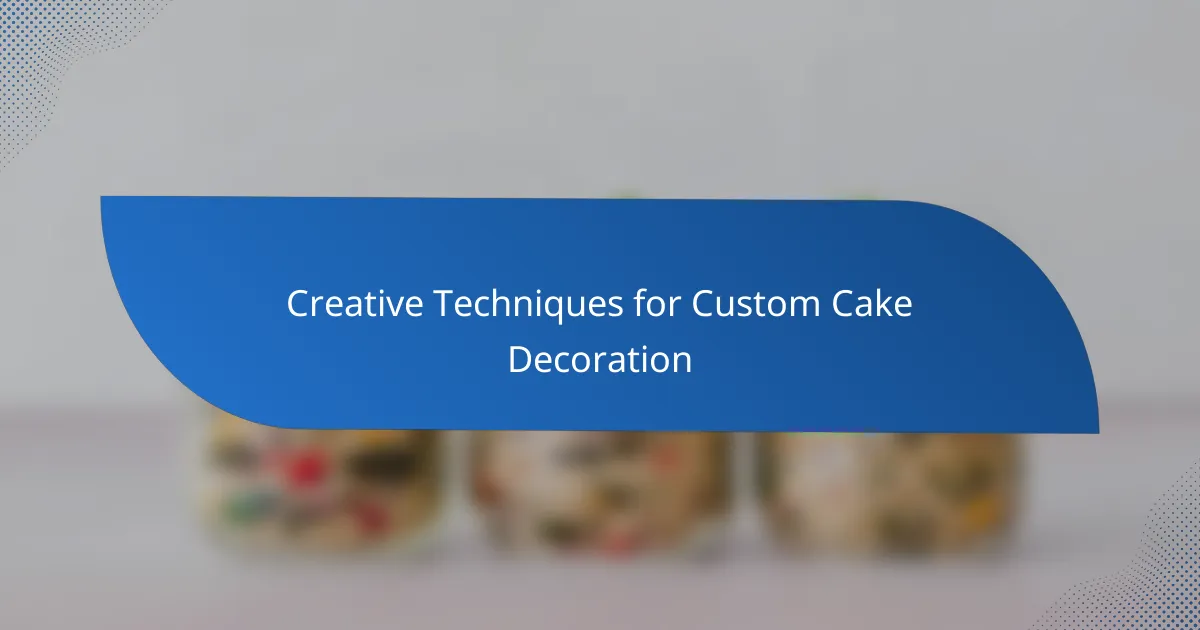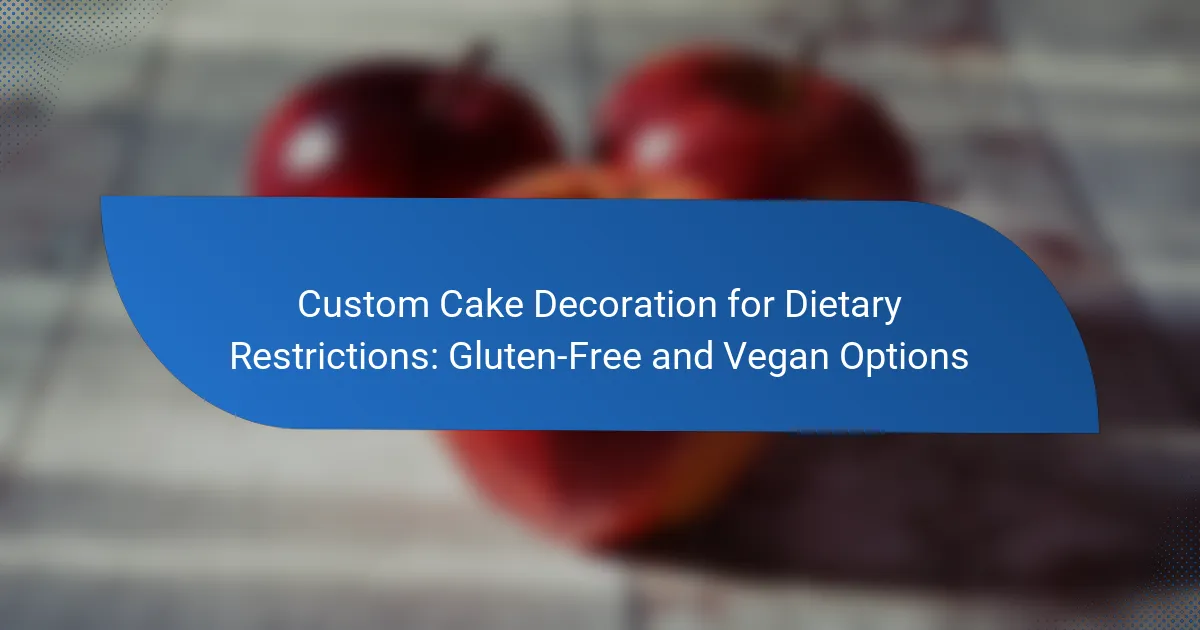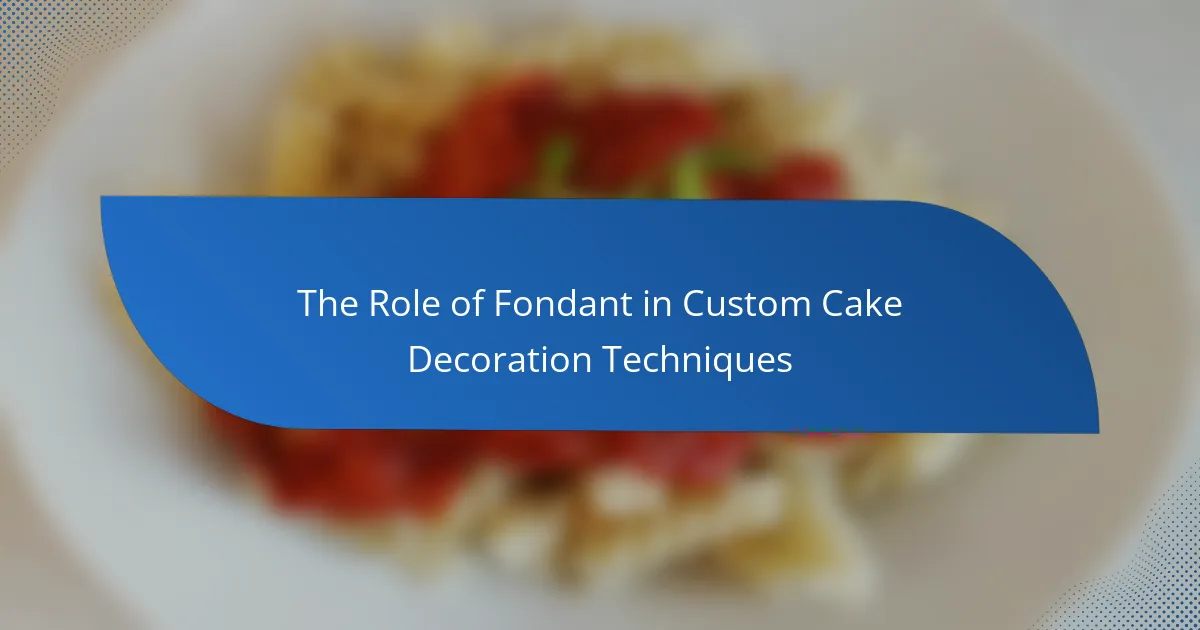This article explores unique flavor combinations for custom cake decoration ideas, highlighting pairings such as lemon and lavender, chocolate and chili, and strawberry and basil. These combinations not only enhance the taste but also improve the visual appeal of cakes. The article provides practical suggestions for implementing these flavors through the use of flavored buttercreams, purees, and fresh fruits, as well as techniques for decorating with edible flowers and drizzles. Additionally, it discusses innovative pairings like matcha white chocolate and rosemary olive oil, offering insights on how to create memorable and aesthetically pleasing cake designs.
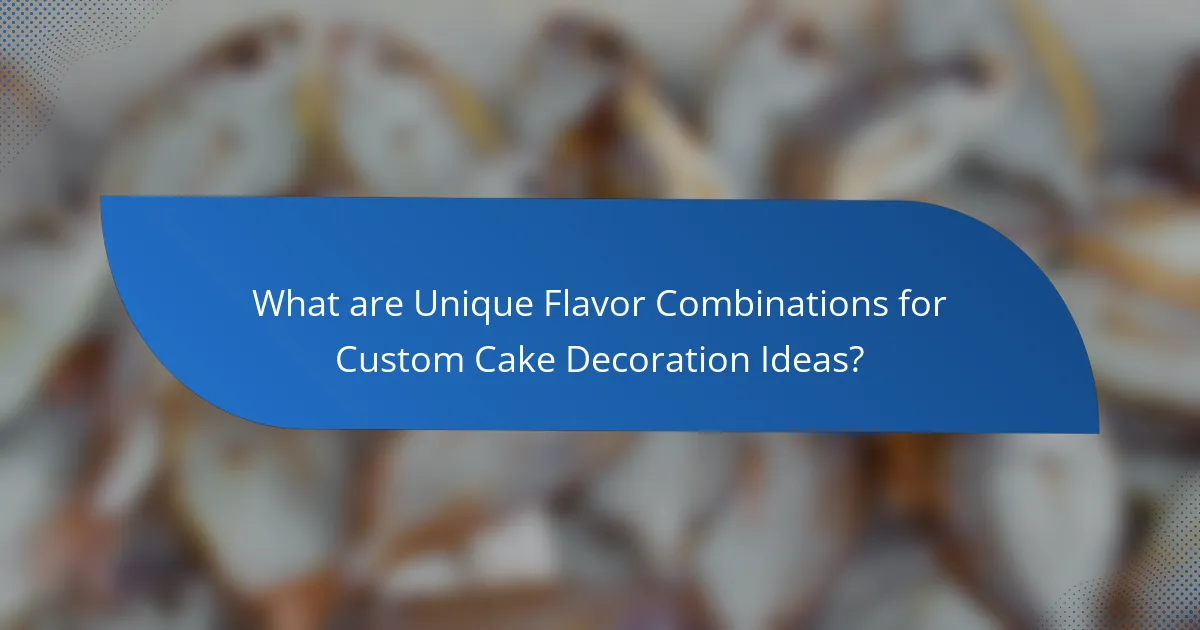
What are Unique Flavor Combinations for Custom Cake Decoration Ideas?
Unique flavor combinations for custom cake decoration ideas include lemon and lavender, chocolate and chili, and strawberry and basil. Lemon and lavender provide a refreshing and aromatic experience. Chocolate and chili add a surprising kick to the rich sweetness. Strawberry and basil create a unique blend of fruity and herbal notes. Other combinations include vanilla and cardamom, which offer warm and spicy undertones. Additionally, coconut and lime bring tropical freshness to cakes. These combinations enhance both flavor and visual appeal, making cakes more memorable.
How can unique flavor combinations enhance cake decoration?
Unique flavor combinations can significantly enhance cake decoration by adding depth and creativity to the overall presentation. These combinations allow decorators to create visually appealing designs that also offer intriguing taste experiences. For instance, pairing citrus flavors with rich chocolate can result in a striking contrast that captures attention. Additionally, unexpected combinations like lavender and honey can evoke a sense of sophistication and uniqueness.
The use of unique flavors can inspire thematic decorations that resonate with specific occasions. For example, a tropical cake with coconut and pineapple flavors can be adorned with vibrant, colorful decorations that reflect a beach theme. Furthermore, incorporating flavors like matcha or chai can introduce an element of cultural richness, enhancing both visual and taste appeal.
Research shows that flavor perception is closely linked to visual presentation, making unique flavor combinations a powerful tool in cake decoration. A study published in the journal “Food Quality and Preference” highlights that consumers are more likely to enjoy and remember foods that offer both visual and flavor diversity. Thus, utilizing unique flavor combinations not only elevates the decoration but also enhances the overall sensory experience.
What are some popular flavor pairings for cake decoration?
Popular flavor pairings for cake decoration include chocolate and raspberry, vanilla and almond, and lemon and blueberry. Chocolate pairs well with raspberry for a rich and tart combination. Vanilla and almond create a classic and smooth flavor profile. Lemon and blueberry offer a refreshing and tangy contrast. Other notable pairings are red velvet with cream cheese and coconut with lime. These combinations enhance the overall taste and visual appeal of cakes. They are frequently used in bakeries and home baking for their popularity.
How do flavor combinations influence the overall cake experience?
Flavor combinations significantly influence the overall cake experience by enhancing taste, aroma, and texture. The right mix of flavors can create a harmonious balance that delights the palate. For instance, pairing chocolate with raspberry adds a tart contrast to the sweetness of the cake. This combination can elevate the sensory experience, making it more memorable. Additionally, flavors like vanilla and almond can create depth and complexity in the cake’s profile. Research indicates that flavor synergy can enhance satisfaction and enjoyment. A study published in the “Journal of Culinary Science & Technology” found that complementary flavors contribute to a more pleasurable eating experience. Thus, thoughtful flavor combinations are essential for creating exceptional cakes.
Why should you consider unique flavor combinations for cakes?
Unique flavor combinations for cakes enhance the overall taste experience. They create memorable desserts that stand out. Unique flavors can surprise and delight the palate. This approach encourages creativity in cake design. According to a study by Food Science Research International, diverse flavor profiles can increase consumer satisfaction. Experimenting with flavors can also cater to various dietary preferences. Incorporating unexpected ingredients can lead to innovative recipes. This trend has been popularized by renowned pastry chefs, showcasing its viability in modern baking.
What benefits do unique flavors bring to cake decoration?
Unique flavors enhance cake decoration by providing distinctive taste experiences. They create memorable desserts that stand out at events. Unique flavors can evoke specific themes or emotions, enhancing the overall celebration. For example, lavender or matcha can add sophistication and intrigue. They also allow for creative combinations, making cakes visually appealing and exciting. Incorporating unique flavors can attract diverse audiences and cater to varying preferences. This approach can increase customer satisfaction and encourage repeat business in bakeries. Overall, unique flavors elevate cake decoration beyond traditional options.
How do unique flavor combinations appeal to different tastes?
Unique flavor combinations appeal to different tastes by offering diverse sensory experiences. These combinations can stimulate various taste receptors, creating a balance between sweet, sour, salty, bitter, and umami flavors. For example, pairing chocolate with sea salt enhances sweetness while adding a savory twist. Similarly, combining citrus with herbs can create refreshing and complex profiles. Research shows that unexpected pairings can increase perceived flavor intensity. According to a study published in the journal “Food Quality and Preference,” unique combinations can lead to higher enjoyment ratings among consumers. This indicates that innovative flavor pairings can attract a broader audience and cater to varied preferences.
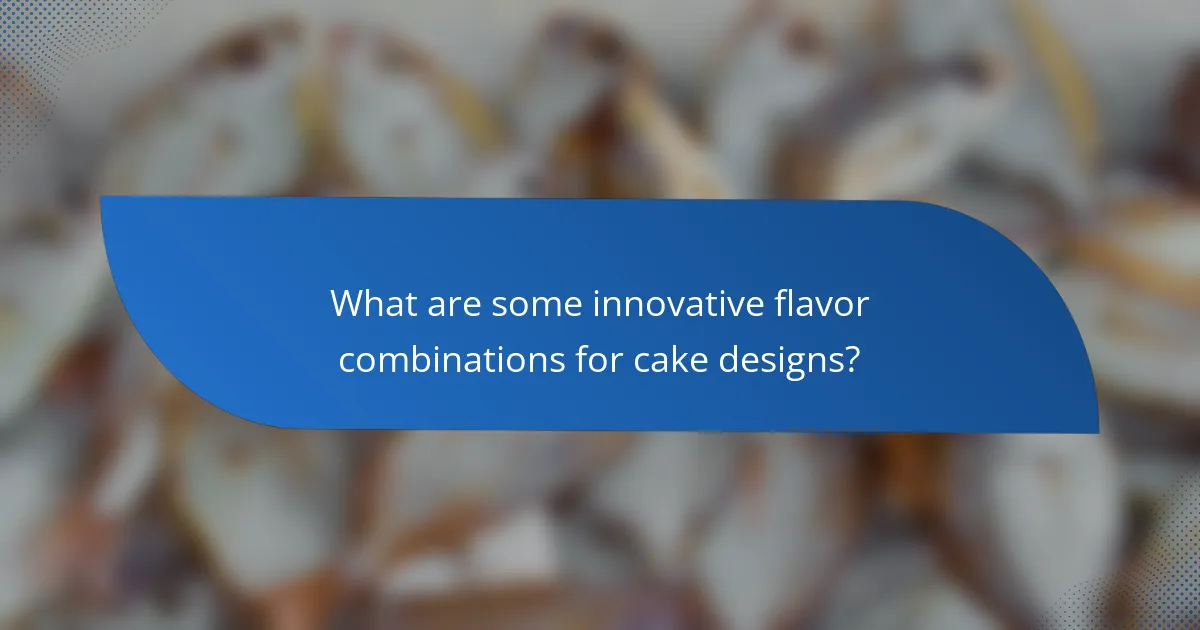
What are some innovative flavor combinations for cake designs?
Innovative flavor combinations for cake designs include lavender lemon, chocolate chili, and matcha white chocolate. Lavender lemon offers a floral note balanced by citrus brightness. Chocolate chili introduces a spicy kick to rich chocolate. Matcha white chocolate combines earthy green tea with creamy sweetness. Other unique pairings are rosemary olive oil and pineapple coconut. Rosemary olive oil enhances cakes with herbaceous depth. Pineapple coconut evokes tropical flavors perfect for summer. These combinations enhance cake designs with distinct tastes and aesthetics.
How can fruits be paired with other flavors for cake decoration?
Fruits can be paired with other flavors for cake decoration by combining them with complementary tastes. For example, berries work well with chocolate or vanilla. Citrus fruits like lemon and orange pair nicely with almond or coconut flavors. Tropical fruits, such as pineapple and mango, can enhance flavors like rum or coconut. Stone fruits, such as peaches and cherries, complement spices like cinnamon or nutmeg. Additionally, fruits can be glazed with honey or syrup to enhance sweetness and add shine. Using herbs like mint or basil can also create a unique flavor profile when paired with fruits. These combinations enhance both the visual appeal and taste of the cake.
What are some examples of fruit and spice combinations?
Examples of fruit and spice combinations include apple and cinnamon, mango and chili, and peach and ginger. Apple pairs well with cinnamon, enhancing its sweetness. Mango with chili adds a spicy kick to its tropical flavor. Peach combined with ginger offers a warm, zesty contrast. These combinations are popular in desserts and savory dishes alike. They create unique flavor profiles that elevate culinary experiences.
How do citrus flavors complement sweet cake elements?
Citrus flavors enhance sweet cake elements by adding brightness and acidity. This contrast balances the sweetness of the cake. The acidity in citrus cuts through rich ingredients like butter and sugar. It prevents the cake from tasting overly sweet. Citrus flavors, such as lemon or orange, introduce refreshing notes. These notes elevate the overall flavor profile of the cake. Studies show that flavor balance is crucial in dessert enjoyment. A well-balanced cake engages multiple taste sensations, improving the eating experience.
What role do herbs and spices play in unique cake flavors?
Herbs and spices enhance unique cake flavors by introducing distinct tastes and aromas. They can transform a standard cake into a gourmet experience. For example, basil adds a fresh, peppery note, while cinnamon brings warmth and sweetness. These ingredients can create unexpected flavor pairings, such as lavender with lemon or rosemary with olive oil. The use of herbs and spices can also elevate texture, providing a complex mouthfeel. Historical baking practices often incorporate these elements, showcasing their enduring appeal. Studies have shown that flavor diversity increases consumer enjoyment and satisfaction. Thus, herbs and spices are essential in crafting unique cake flavors.
Which herbs can elevate cake decoration flavors?
Mint, rosemary, basil, and lavender can elevate cake decoration flavors. Mint adds a refreshing taste that pairs well with chocolate and vanilla. Rosemary provides a unique, earthy flavor that complements citrus cakes. Basil offers a sweet and peppery note, enhancing fruit-based decorations. Lavender contributes floral notes, perfect for delicate desserts. These herbs can transform traditional cake flavors into innovative culinary experiences.
How can spices like cinnamon or nutmeg enhance cake profiles?
Spices like cinnamon and nutmeg can enhance cake profiles by adding warmth and depth to the flavor. Cinnamon introduces a sweet, aromatic quality that complements various cake bases. Nutmeg contributes a slightly nutty and spicy undertone, which can elevate the overall taste experience. These spices work well in combination with sweet ingredients, creating a balanced flavor profile. In baked goods, cinnamon has been shown to enhance sweetness perception, allowing for reduced sugar usage. Nutmeg, when used sparingly, can create a unique flavor contrast that intrigues the palate. Together, they can transform a simple cake into a complex dessert that delights the senses.
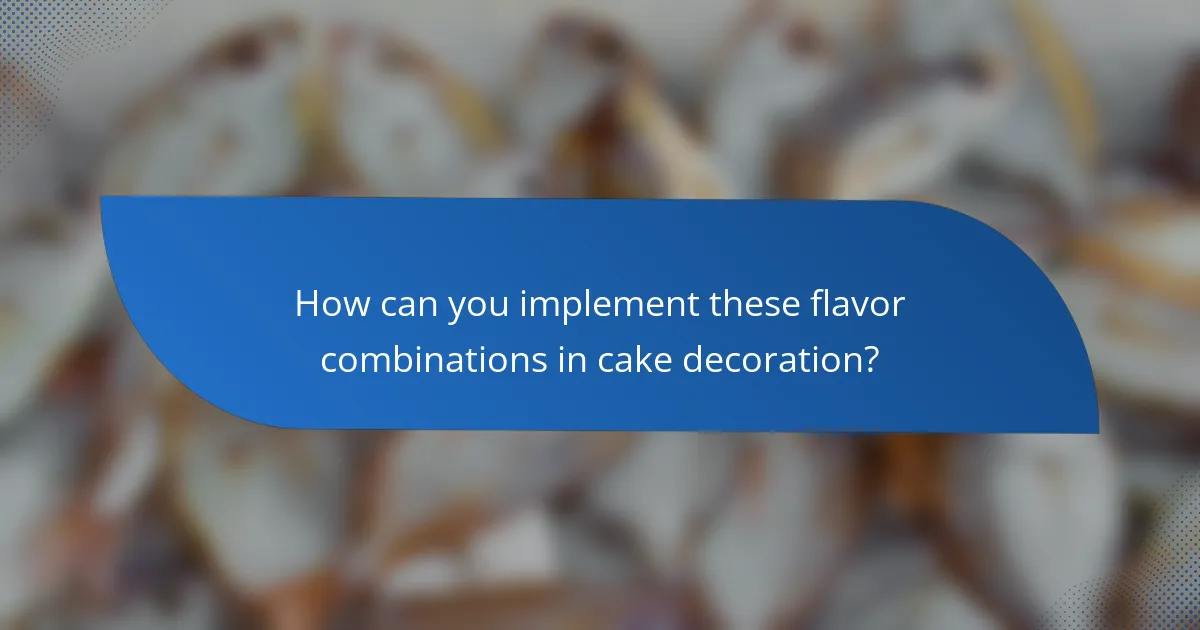
How can you implement these flavor combinations in cake decoration?
To implement flavor combinations in cake decoration, start by selecting complementary flavors. For example, pairing chocolate with raspberry creates a rich and fruity profile. Use flavored buttercreams to enhance the cake’s taste. Incorporate purees or extracts into the frosting for added depth.
Decorate with fresh fruits that match the chosen flavors. For instance, use citrus zest with vanilla frosting for a bright contrast. Edible flowers can also add flavor and visual appeal. Drizzle sauces that align with the cake’s flavor, such as caramel or citrus glaze.
Finally, consider using flavored ganaches or glazes to finish the cake. These methods effectively showcase unique flavor combinations while enhancing the cake’s overall aesthetic.
What techniques can be used to showcase unique flavors in cakes?
To showcase unique flavors in cakes, bakers can use flavor layering techniques. This involves incorporating different flavors in each layer of the cake. For example, a chocolate cake can have layers of raspberry, vanilla, and espresso.
Another technique is flavor-infused syrups. These syrups can be brushed onto cake layers to enhance moisture and flavor. Common infusions include citrus, herbs, or spices.
Using flavored frostings is also effective. Cream cheese, buttercream, or ganache can be made with unique flavor profiles like lavender or chai.
Bakers may also incorporate unique fillings. Options include fruit compotes, flavored mousses, or custards that complement the cake’s main flavor.
Additionally, garnishing with fresh herbs or edible flowers can highlight cake flavors. These elements add visual appeal and aromatic qualities.
Finally, experimenting with texture can emphasize flavors. This can involve adding crunchy elements like nuts or crispy toppings that contrast with the cake’s softness.
How can layering flavors enhance the visual appeal of cakes?
Layering flavors can significantly enhance the visual appeal of cakes by creating distinct color contrasts and textures. Each layer can showcase a different flavor, contributing to a vibrant presentation. For example, a chocolate layer can be visually striking against a light vanilla layer. This contrast not only attracts the eye but also invites curiosity about the taste. Additionally, incorporating colorful fillings or frostings between layers adds depth and interest. A cake with multiple flavors can be sliced to reveal beautiful patterns, enhancing its overall aesthetic. Studies have shown that visually appealing food can increase appetite and enjoyment, making layered cakes more enticing.
What are some methods for incorporating flavors into frosting and fillings?
Incorporating flavors into frosting and fillings can be achieved through several effective methods. One method is using extracts, such as vanilla, almond, or citrus, which provide concentrated flavor. Another method involves adding pureed fruits, like strawberries or mangoes, which enhance taste and add moisture. Additionally, infusing frosting with spices, such as cinnamon or nutmeg, can create warm flavor notes.
Using flavored syrups, like chocolate or caramel, can also intensify sweetness and taste. Incorporating cocoa powder or melted chocolate allows for rich chocolate flavors. For a unique twist, adding zests from citrus fruits can brighten the flavor profile. Finally, using flavored cream cheese or mascarpone as a base can introduce a distinct taste to the frosting or filling. These methods ensure a diverse and flavorful experience in cake decoration.
What are some tips for experimenting with unique flavor combinations?
Start by pairing contrasting flavors, such as sweet and savory. For example, chocolate with sea salt enhances sweetness. Use herbs and spices to introduce complexity. Basil pairs well with strawberries, creating a fresh twist. Experiment with acidity to balance flavors. Citrus can brighten rich ingredients like cream. Incorporate textures for added interest, like crunchy nuts in a smooth cake. Keep a flavor journal to document successful combinations. This helps track what works well together. Taste as you go to adjust flavors in real-time.
How can you balance flavors to avoid overpowering the cake?
To balance flavors and avoid overpowering the cake, use complementary ingredients. Pair sweet flavors with a hint of acidity to create contrast. For example, citrus zest can enhance sweetness without overwhelming it. Additionally, incorporate spices like cinnamon or nutmeg to add depth without dominance. Use light flavors, such as vanilla or almond, in moderation to maintain balance. Adjust the sweetness level by using less sugar in frosting or fillings. A well-balanced cake typically has a harmonious blend of flavors, as seen in classic recipes. This approach ensures that no single flavor overshadows the others.
What are common mistakes to avoid when creating unique flavor combinations?
Common mistakes to avoid when creating unique flavor combinations include overlooking balance, ignoring complementary flavors, and failing to consider texture. A lack of balance can lead to overpowering tastes. Ignoring complementary flavors may result in discordant combinations. Failing to consider texture can create an unappealing mouthfeel. Additionally, not testing combinations before finalizing can lead to unexpected results. Using too many strong flavors simultaneously can overwhelm the palate. Lastly, neglecting seasonal ingredients may limit creativity and freshness.
The main entity of the article is unique flavor combinations for custom cake decoration ideas. The article explores various innovative flavor pairings, such as lemon and lavender, chocolate and chili, and strawberry and basil, highlighting how these combinations enhance both taste and visual appeal. It discusses the impact of flavor combinations on cake decoration, consumer satisfaction, and the overall sensory experience, while also providing practical tips for incorporating these flavors into cakes. Additionally, the article covers techniques for showcasing flavors in frosting and fillings, as well as common mistakes to avoid when experimenting with unique flavor combinations.

